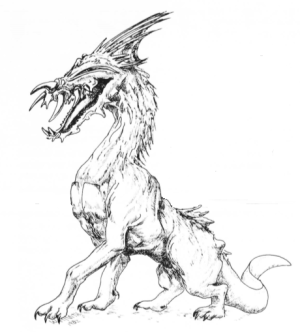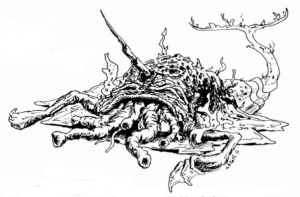Unnamed World
An Unnamed World is an unexplored or unclaimed mainworld.
- Its primary star normally has a designation, typically a stellar catalog reference number.
- The other secondary worlds of its system are usually also unnamed.
Description / Specifications[edit]
This world has not been officially named and may not have been extensively charted.
- It is likely to be informally known by a variety of names.
- Individuals exploring the star system may be entitled to name the world.
- Its natural resources may be entirely untapped.
World Listings[edit]
AAB library archives contain expanded data about the star systems and worlds of Charted Space. However, these data archives rely on the fact that the world is named on star charts.
- The AAB archives do not contain detailed information about an unnamed world or its star system.
- UWP data regarding the world and its star system can still be obtained from Sector Data files and Sector Summary files.
- Its basic "natural" trade codes will help indicate the nature of the world.
History & Background / Dossier[edit]
The world may be totally unexplored and almost completely unknown.
The world may have been explored at some time in the past, though any data is not readily available and may be difficult to retrieve. Such data may include:
- Astrographic charts of its system.
- Maps of the worlds surface.
- Data pertaining to its size, physical structure and geology.
- Its atmospheric composition and the nature of any hydrosphere.
- The presence of native life.
Such data may also include notes about unusual or interesting features that can be found on the world.
- There may be a serious hazard or danger present on the world, such as a disease.
- There may be a particularly notable or abundant resource.
- It may have spectacular surface features, such as gigantic craters, vast persistent storms, colored deserts, or deep canyons.
There may be rumors and stories about the world told around the region. While many of these are simply tall tales, some may contain a kernel of truth.
Native Life[edit]
Within Charted Space, the majority of lifeforms have a similar biological basis: they are carbon-based, rely on breathing oxygen, and utilize liquid water as part of their lifecycle.
- Native life is an important thing: it can provide breathable air, resources, food, and energy (such as wood to burn).
- Native life may present a considerable danger.
Atmosphere and Hydrosphere[edit]
The local atmosphere and hydrosphere dramatically affect the chances of a world having native life.
- Planetoid belts almost never have native life.
- Vaccuum and trace atmosphere worlds rarely have surface-dwelling native life.
- Very thin atmosphere, thin atmosphere, standard atmosphere and dense atmosphere types are good indicators of the presence of native life.
- These atmosphere types contain oxygen, which is most often present as the result of the metabolic processes of native organisms.
- A few worlds with oxygen-rich atmospheres - perhaps around 5% - do not have native life and gain their oxygen through abiotic processes.
- Exotic atmospheres typically contain little or no oxygen. They may be capable of supporting exotic lifeforms that don't use oxygen in respiration.
- The presence of liquid water on the surface of a world greatly increases the chances of there being native life.
- Exotic surface fluids may potentially harbor bizarre organisms.
Climate[edit]
Local climate can also affect the chances of native life. Temperature on the world is dictated by its distance from the star: if it orbits within the habitable zone it is more likely to have liquid water on its surface and have conditions conducive to conventional carbon-oxygen lifeforms.
- Tropical Worlds Temperate Worlds, or Tundra Worlds may offer near ideal conditions for life.
- Inferno Worlds, Hot Worlds, Cold Worlds, or Frozen Worlds are less likely to support life.
- Ice Worlds may have hostile near-vacuum surface conditions but have planet-wide liquid water oceans below their icy outer crusts.
- These sub-ice oceans are kept liquid by internal heat, the high pressure caused by the thick icy crust above them, and by tidal stresses generated by the star, by satellites, and by other planets within the system.
- They may contain strange forms of aquatic native life.
Types of Life[edit]
Cyanobacteria-Parallels:
Perhaps the simplest form of life, and the only form of life existing on a large number of worlds. Their metabolic processes change the nature of the atmosphere and environment, often making it more conducive to more sophisticated forms of life. They tend to die off as the local environment changes (in that regard they are responsible for their own demise) or are out-competed for limited resources as more complex organisms begin to evolve.
- Cyanobacteria are microscopic.
- They thrive within all kinds of primitive environments.
- They may be responsible for planetary oxygenisation events (the atmosphere gaining a significant percentage of oxygen).
Primitive Native Life:
Single-celled and multicellular organisms that exist in a wide variety of environments. They may be free-ranging, form organic slimes or mats, or cluster into stromatolite-parallels. Their metabolic processes drive the process of atmospheric renewal.
- They may have characteristics associated with both plants and animals.
- The largest individual organisms are perhaps a few millimeters across.
- They particularly thrive in surface fluids such as water.
Complex Native Life:
Specialised organisms, often motile and capable of independent action. They fill every available ecological niche. Their metabolic processes drive the process of atmospheric renewal.
- Such organisms have generally specialised into flora (plants) and fauna (animals).
- Animals may range from the microscopic to megafauna.
- Within each environment there is often a complex pyramid of organisms based on dietary needs, topped by an apex predator.
Life is extremely adaptable and complex native organisms may have found a means to exist in hostile conditions such as an arid desert or an exotic surface fluid.
- Such organisms are known as extremophiles.
- Their preferred environmental conditions often very quickly kill conventional carbon-oxygen lifeforms.
Native Sophonts[edit]
The world may be the homeworld of one or more currently unknown native sophont species.
- Generally a world requires Complex Native Life in order to have a native sophont species.
If they do exist on the world, a First Contact situation may develop.
- The native species may be unaware of the existence of other forms of life beyond their own world.
- They may exist at relatively low levels of technology and lack the means to initiate contact.
Alternatively, any such sophonts may choose not to advertise their presence or may even deliberately hide.
- They may be difficult to detect due to their local environmental conditions or preferences, such as species that exist within deep aquatic or subterranean regions.
A now extinct sophont species may once have inhabited the world.
- There may be the ruins and remains of a past civilization on the surface.
- The original architects of these remains may have been a native species or offworld visitors.
Political Astrography[edit]
Polity Listing[edit]
No polities are known to directly claim the world.
- Some polities may make grand statements about "owning all the stars in the subsector", but any such claims have not been enforced on this particular world.
Population[edit]
No information is currently available regarding population levels on the world.
- The world may be completely barren and empty of intelligent life.
- Unrecorded individuals or groups may be present on the world.
Demographics[edit]
Various organisations or individuals may be active on the world. These may include:
- Governmental agencies conducting official activities – most typically Scouts carrying out surveys – or universities and other institutes of learning exploring its surface.
- Such study and research may be carried out directly, by individuals travelling into the unknown and performing research and study first-hand.
- Corporations and businesses may be exploring the world, looking to exploit natural resources or find new commercial opportunities.
- They may wish to keep their activities secret for commercial reasons.
- Covert or criminal groups, generally seeking anonymity, may be present on the world.
- Groups or individuals who seek isolation or solitude may have settled the world.
- Exploration may be being conducted by private individuals such as pioneers, prospectors, beast-hunters in search of exotic new game, or those who seek adventure beyond the frontier.
- Stranded spacefarers (or their descendants) may be involuntarily resident on the world, perhaps as the result of a misjump.
Groups or organisations may hold significantly more data on the world than is generally available.
- They may run or control covert facilities or secret bases on the world.
- They may proactively try to conceal their activities.
References & Contributors / Sources[edit]
| This article is missing content for one or more detailed sections. Additional details are required to complete the article. You can help the Traveller Wiki by expanding it. |
- Author & Contributor: Lord (Marquis) and Master Scout Emeritus Adie Alegoric Stewart of the IISS


